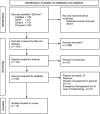Design and Framework for Developing Disaster Health Information System (DHIS): A Systematic Review
- PMID: 39444476
- PMCID: PMC11493570
- DOI: 10.18502/ijph.v53i4.15552
Design and Framework for Developing Disaster Health Information System (DHIS): A Systematic Review
Abstract
Background: Health information systems are critically important in disaster management. It supports disaster management activities and the information needed for decision-making support. We aimed to evaluate comprehensively published literature on disaster health information systems designed to identify and extract the required framework and components.
Methods: A systematic review approach was used to systematically seek, screen, and synthesize data extracted from papers on using health information systems in disasters from the electronic databases (Scopus, PubMed, ProQuest, and SAGE) with no limit up to Jan 2022 following the PRISMA declaration for reporting. The inclusion criteria consisted of full-text journal articles, publications in English, and studies focusing on disaster health information systems, critically evaluated articles using the Joanna Brigg Institute (JBI). Content analysis was used to analyze extracted data.
Results: Of 998 identified references, 18 articles were finally included and analyzed in this study and they are good quality according to appraisal results using JBI. Most reports described research of development or working prototypes and working framework; only two referred to early research or proposed design or framework. Of 18 articles; identified into 3 themes; 4 DHISs in pre-disaster, thirteen DHISs used during the disaster, and one DHIS in post-disaster were identified.
Conclusion: All the systems have a design or framework starting from strategies and plans, information flow, disaster management, and operation engagement, and involve all stakeholders, including the community. Its systems are supported by the latest technology and methods and the principles of integration and interoperability to obtain a DHIS that can assist decision-making processes.
Keywords: Component; Design; Disaster; Health information system.
Copyright© 2024 Iman et al. Published by Tehran University of Medical Sciences.
Figures
Similar articles
-
Beyond the black stump: rapid reviews of health research issues affecting regional, rural and remote Australia.Med J Aust. 2020 Dec;213 Suppl 11:S3-S32.e1. doi: 10.5694/mja2.50881. Med J Aust. 2020. PMID: 33314144
-
The Effectiveness of Integrated Care Pathways for Adults and Children in Health Care Settings: A Systematic Review.JBI Libr Syst Rev. 2009;7(3):80-129. doi: 10.11124/01938924-200907030-00001. JBI Libr Syst Rev. 2009. PMID: 27820426
-
Health Care Organizations' Interoperability during Multi-Organizational Disaster Management: A Scoping Review.Prehosp Disaster Med. 2022 Jun;37(3):401-408. doi: 10.1017/S1049023X22000516. Epub 2022 Apr 5. Prehosp Disaster Med. 2022. PMID: 35379377
-
Promoting and supporting self-management for adults living in the community with physical chronic illness: A systematic review of the effectiveness and meaningfulness of the patient-practitioner encounter.JBI Libr Syst Rev. 2009;7(13):492-582. doi: 10.11124/01938924-200907130-00001. JBI Libr Syst Rev. 2009. PMID: 27819974
-
Role of Religious Institutions in Disaster Risk Management: A Systematic Review.Disaster Med Public Health Prep. 2021 Apr;15(2):239-254. doi: 10.1017/dmp.2019.145. Epub 2020 Feb 17. Disaster Med Public Health Prep. 2021. PMID: 32063259 Review.
References
-
- UN world conference on disaster risk reduction (2015). Sendai framework for disaster risk reduction 2015–2030, 1st ed. Geneva.
-
- Tekeli-Yeşil (2006). Public health and natural disasters: disaster preparedness and response in health systems Sidika. J Public Health, 14 :317–324.
-
- Kaur M, Kaur PD, Sood SK. (2022). ICT in disaster management context: a descriptive and critical review. Environ Sci Pollut Res Int, 29 (57): 86796–86814. - PubMed
-
- Ali A, Changazi SA, Rizwan HMA, et al. (2022). A GIS Architecture for Medical Disaster Management to Support Modern Healthcare Management System. In: 2022 2nd Int. Conf. Artif. Intell. ICAI. IEEE, Islamabad, Pakistan, pp 13–18.
Publication types
LinkOut - more resources
Full Text Sources


